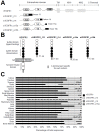Splice Variants of the RTK Family: Their Role in Tumour Progression and Response to Targeted Therapy
- PMID: 28208660
- PMCID: PMC5343918
- DOI: 10.3390/ijms18020383
Splice Variants of the RTK Family: Their Role in Tumour Progression and Response to Targeted Therapy
Abstract
Receptor tyrosine kinases (RTKs) belong to a family of transmembrane receptors that display tyrosine kinase activity and trigger the activation of downstream signalling pathways mainly involved in cell proliferation and survival. RTK amplification or somatic mutations leading to their constitutive activation and oncogenic properties have been reported in various tumour types. Numerous RTK-targeted therapies have been developed to counteract this hyperactivation. Alternative splicing of pre-mRNA has recently emerged as an important contributor to cancer development and tumour maintenance. Interestingly, RTKs are alternatively spliced. However, the biological functions of RTK splice variants, as well as the upstream signals that control their expression in tumours, remain to be understood. More importantly, it remains to be determined whether, and how, these splicing events may affect the response of tumour cells to RTK-targeted therapies, and inversely, whether these therapies may impact these splicing events. In this review, we will discuss the role of alternative splicing of RTKs in tumour progression and response to therapies, with a special focus on two major RTKs that control proliferation, survival, and angiogenesis, namely, epidermal growth factor receptor (EGFR) and vascular endothelial growth factor receptor-1 (VEGFR1).
Keywords: EGFR; VEGFR; alternative splicing; angiogenesis; cancer; receptor tyrosine kinases; targeted therapies; tumourigenesis.
Conflict of interest statement
The authors declare no conflict of interest.
Figures



References
Publication types
MeSH terms
Substances
LinkOut - more resources
Full Text Sources
Other Literature Sources
Molecular Biology Databases
Research Materials
Miscellaneous

